
No fatal accidents related1 to air navigation services (ANS) were reported involving commercial air transport airplanes weighing more than 2,250 kg (4,960 lb) in Eurocontrol member states from 2011 through 2014, the agency said in its annual performance review (Figure 1).2
Figure 1 — Accidents in the Eurocontrol Area, 2004–2014
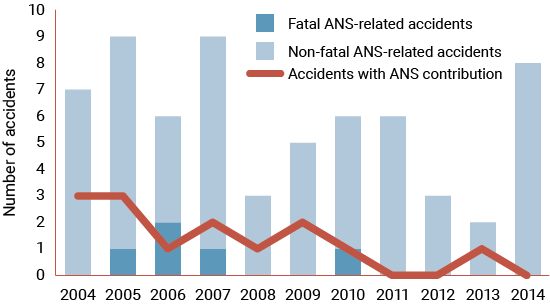
ANS = air navigation services
Source: Source: Eurocontrol Performance Review Commission
During the same time frame, one nonfatal accident “with ANS contribution” was reported, and nonfatal ANS-related accidents increased to eight in 2014, after a downturn that had lasted over several years, said the report, published in May.
“Overall, safety levels in Europe continue to remain high, yet with scope for further improvements in some areas,” the report said, noting that ANS has been a factor in two accidents in the past five years.
The document noted “a number of foreseen and unforeseen events in 2014,” and added that “the tragic loss of [Malaysia Airlines] MH17 in Ukrainian airspace in July was undoubtedly the most significant event in European airspace during 2014.” Preliminary reports indicate the Boeing 777 was shot down on July 17 as it crossed over an area of fighting between Ukrainian separatists and government forces. All 298 people aboard were killed.
As a result of the crash, the report said, “there was a notable shift of traffic.” Air traffic decreased 37 percent in Ukraine and 24 percent in Moldova but increased by 24 percent in Bulgaria and by smaller percentages in Romania, Hungary, Turkey and Slovakia.
Most ANS-related accidents in 2012, 2013 and 2014 were related to bad weather, the report said, citing data that placed seven accidents in that category (Figure 2). During that three-year period, four accidents were related to ground collisions, and one accident was recorded in each of five other categories.
Figure 2 — ANS-Related Accidents by Occurrence Category in the Eurocontrol Area
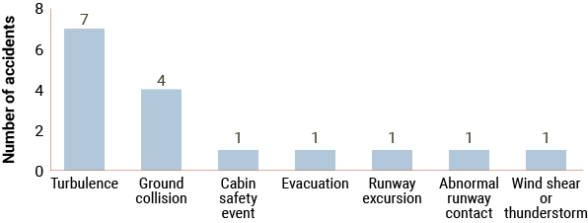
ANS = air navigation services
Source: Source: Eurocontrol Performance Review Commission
Figure 3 shows a steady decrease since 2010 in serious incidents with ANS contribution to an 11-year low of five, while ANS-related serious incidents increased from eight in 2013 to 23 in 2014.
Figure 3 — Serious Incidents in the Eurocontrol Area, 2004–2014
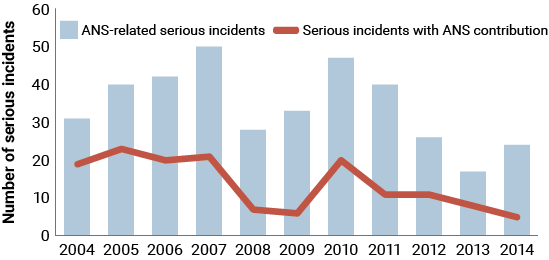
ANS = air navigation services
Source: Source: Eurocontrol Performance Review Commission
In 2012–2014, 32 ANS-related serious incidents were recorded as near-midair collisions — the greatest number in any occurrence category, the report said (Figure 4). In addition, 15 ANS-related serious incidents were categorized as runway incursion incidents involving vehicles, aircraft or individuals.
Figure 4 — ANS-Related Serious Incidents by Occurrence Category in the Eurocontrol Area
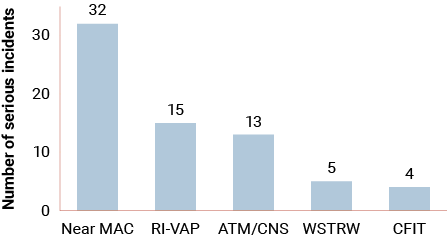
ANS = air navigation services; ATM/CNS = air traffic management/communication, navigation, surveillance; CFIT = controlled flight into terrain; Near MAC = near-midair collision; RI-VAP = runway incursions — vehicle, aircraft person; WSTRW = wind shear or thunderstorm
Source: Source: Eurocontrol Performance Review Commission
Eurocontrol data show that the number of separation minima infringements (SMIs) increased by almost 17 percent in 2013, the most recent year for which final data are available, to a total of 2,097 (Figure 5); of that number, 30 SMIs were classified as “risk-bearing.” Preliminary data for 2014 show 2,274 SMIs were reported, including 21 risk-bearing SMIs.
Figure 5 — Reported High-Risk Separation Minima Infringements in Eurocontrol States, 2004–2014
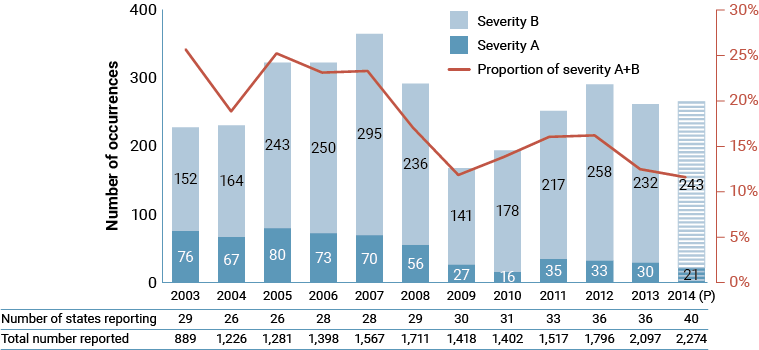
Notes: Severity B refers to a major incident, which Eurocontrol defines as one in which the safety of aircraft “may have been compromised.”
Severity A refers to a serious incident, which Eurocontrol defines as one that involves “circumstances indicating that an accident nearly occurred.”
Source: Source: Eurocontrol Performance Review Commission
Data also show a 15 percent increase in reported runway incursions in 2013, with 1,421 incursion reports; of the total, 75 incursions were considered risk-bearing (Figure 6). Preliminary 2014 data show a total of 1,439 reported incursions, 101 of which were considered risk-bearing.
Figure 6 — Reported High-Risk Runway Incursions in Eurocontrol States, 2004–2014
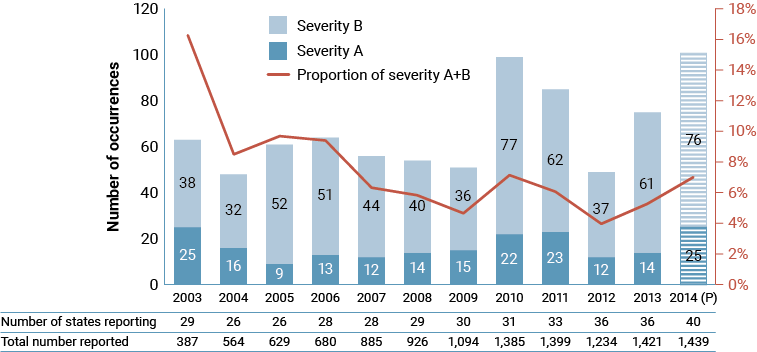
Notes: Severity B refers to a major incident, which Eurocontrol defines as one in which the safety of aircraft “may have been compromised.”
Severity A refers to a serious incident, which Eurocontrol defines as one that involves “circumstances indicating that an accident nearly occurred.”
Source: Source: Eurocontrol Performance Review Commission
The report noted that, after a continuous increase in incident reporting between 2004 and 2012, the total number of incidents reported declined in 2013, down 17 percent from 2012 levels. “However,” the report said, “it is difficult to differentiate whether the decrease in 2013 is due to genuine safety performance improvements or a drop in the level of reporting.”
Final data from 2013 was submitted by 36 Eurocontrol member states, and 2014 preliminary data came from a record 40 states, the report said.
The report noted “the need to accelerate the deployment of automatic safety data monitoring to complement manual reporting.”
The document also called for an “improved understanding of how the various elements of the ATM [air traffic management] system contribute to overall safety levels,” adding that such understanding “not only helps to better identify risk areas today but also how modifications to the system could improve performance in the future.”
Notes
- According to Eurocontrol definitions, ANS-related means that “the ANS system may not have had a contribution to a given occurrence, but it may have a role in preventing similar occurrences in the future.” ANS contribution means that “at least one ANS factor was in the causal chain of events leading to an occurrence, or at least one ANS factor potentially increased the level of risk, or it played a role in the occurrence encountered by the aircraft.”
- Eurocontrol Performance Review Commission. PRR2014, Performance Review Report. May 21, 2015.




